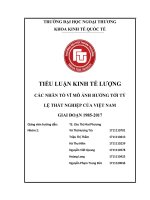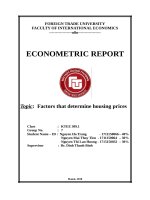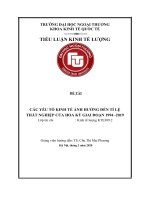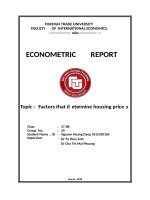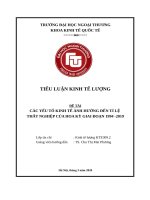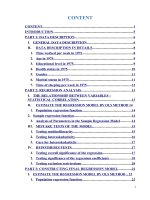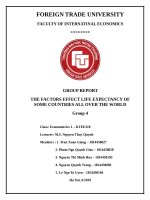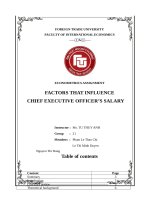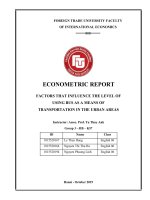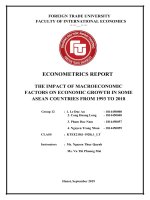tiểu luận kinh tế lượng factors that determine housing prices
Bạn đang xem bản rút gọn của tài liệu. Xem và tải ngay bản đầy đủ của tài liệu tại đây (880.75 KB, 16 trang )
FOREIGN TRADE UNIVERSITY
FACULTY
OF INTERNATIONAL ECONOMICS
----------------- o0o--------------- --
ECONOMETRIC
REPORT
Topic : Factors that d etermine housing price s
Class
Group No.
Student Name – ID
Supervisor
:
:
:
:
57 JIB
29
Nguyen Hoang Dang 1815520160
Dr Tu Thuy Anh
Dr Chu Thi Mai Phuong
H anoi, 2018
Group 7 Econometric Report
Table of Contents
I. Introduction...................................................................................................................... 3
II. Literature overview........................................................................................................3
1. Questions of interest....................................................................................................................3
2. Procedure and program used.......................................................................................................3
III. Economic model............................................................................................................4
1. Specifying the object for modeling..............................................................................................4
2. Defining the target for modeling by the choice of the variables to analyze, denoted xi.........4
3. Embedding that target in a general unrestricted model (GUM)..................................................4
IV. Econometric model........................................................................................................5
V. Data collection.................................................................................................................5
1. Data overview..............................................................................................................................5
2. Data description...........................................................................................................................5
VI. Estimation of econometric model.................................................................................6
1. Checking the correlation among variables..................................................................................6
2. Regression run.............................................................................................................................8
VII. Check multicollinearity and heteroscedasticity.........................................................9
1. Multicollinearity..........................................................................................................................9
2. Heteroskedasticity......................................................................................................................10
VIII. Hypothesis postulated..............................................................................................12
1. The impact of neighborhood factors..........................................................................................12
2. The impact of accessibility factors............................................................................................13
IX. Result analysis & Policy implication..........................................................................14
X. Conclusion..................................................................................................................... 15
XI. References....................................................................................................................16
Exhibit 1: Definition of variables in the Housing Price model .......................................................... 4
Exhibit 2: Statistic indicators of variables in the Housing Price model ........................................... 5
Exhibit 3: Correlation matrix .............................................................................................................. 6
Exhibit 4: Scatterplot of variables in the Housing Price model ........................................................ 7
Exhibit 5: Regression model................................................................................................................. 8
Exhibit 6: Multicollinearity test ........................................................................................................... 9
Exhibit 7: Heteroskedasticity test ...................................................................................................... 10
Exhibit 8: Residual-versus-fitted plot of the Housing Price model ................................................ 11
Exhibit 9: Correcting heteroskedasticity .......................................................................................... 11
2
Group 7 Econometric Report
Exhibit 10: Hypothesis testing of multiple regression model of neighborhood factors ................ 12
Exhibit 11: Hypothesis testing of multiple regression model of accessibility factors .................... 13
I. Introduction
As much as Economy is a meaningful science that determines the social development in
general and national growth in particular, Econometrics is the use of statistical techniques
to understand those issues and test theories. Without evidence, economic theories are
abstract and might have no bearing on reality (even if they are completely rigorous).
Econometrics is a set of tools we can use to confront theory with real-world data.
Given the data set, our group, which includes three members: Nguyen Ha Trang, Nguyen Mai
Thuy Tien, and Nguyen Thi Lan Huong, follows the methodology of econometric comprising
eight steps to analyze the data. Note that because of the lack of information on the data set, all
inferences of abbreviations and others are based on assumptions and self-research. As a result,
we hope to have shown clearly our logic and reasoning of analysis.
To the extent of purpose and resources, there are still deficiencies in this report, but we look
forward to providing readers with a decent view of the overall of the data set given and the
knowledge that we have gained through Dr. Dinh Thanh Binh’s Econometrics course.
II. Literature overview
1. Questions of interest
“Why do housing prices differ among locations and regions?” – this is the basic question to
which this report targets to find the answer. Although there is a variety of factors that might
affect housing prices, they are divided into four main categories: structure, neighborhood,
accessibility, and air pollution. Consequently, elements that represent each of these categories
are taken into account to find out whether they do, or at least statistically do have an impact
on housing prices.
In following parts, models are going to be built, data are going to be used in order to run the
regression model and then the results are going to be analyzed to finally answer the question
of interest above.
2. Procedure and program used
• Procedure
Step 1: Questions of interest
Step 2: Economic model
Step 3: Econometric model
Step 4: Data collection
Step 5: Estimation of econometric model
Step 6: Check multicollinearity and heteroscedasticity
Step 7: Hypothesis postulated
Step 8: Result analysis & Policy implication
• Stata program is primarily used to analyze the data and run the regression.
3
Group 7 Econometric Report
III. Economic model
As data are provided up front, the economic model used in this report is an empirical one.
Note that the fundamental model is mathematical; with an empirical model, however, data is
gathered for the variables and using accepted statistical techniques, the data are used to
provide estimates of the model's values.
Empirical model discovery and theory evaluation are suggested to involve five key steps, but
for the limitation of purpose and resources, this part of the report only follows three of them:
(1) specifying the object for modeling, (2) defining the target for modeling, (3) embedding
that target in a general unrestricted model.
1. Specifying the object for modeling
price f x
(1)
As such, this report finds the relationship between housing price, which is the object for
modeling, and each of relating factors including structure, neighborhood, accessibility, and air
pollution ones.
2. Defining the target for modeling by the choice of the variables to analyze, denoted
xi
As mentioned above, there are four main categories that are expected to affect housing prices:
structure, neighborhood, accessibility, and air pollution. Hence, the choices of xi would be
such variables that constitute them. After thorough research, factors have been narrowed down
to eight significant ones: (structure) number of rooms, (neighborhood) crimes, property tax,
the percentage of people of low status, student-teacher ratio, (accessibility) distances to
employment centers, accessibility to radial highways and (air pollution) nitrous oxide.
3. Embedding that target in a general unrestricted model (GUM)
In its simplest acceptable representation (which will later be specified in the econometric
model), the GUM of is determined to be: lprice f
crim,nox,rooms,dist,radial,
proptax,stratio,lowstat A brief description of each variable is given in Exhibit 1.
Exhibit 1: Definition of variables in the Housing Price model
Variable
lprice
crime
nox
rooms
dist
radial
proptax
stratio
4
Definition
logarithm of median housing price, $
crimes committed per capita
nitrous oxide, parts per 100 million square
average number of rooms per house
weighted distances to 5 employment centers
accessibility index to radial highways
property tax per $1000
average student-teacher ratio
Group 7 Econometric Report
lowstat
percentage of people of low status
IV. Econometric model
To demonstrate the relationship between housing price and other factors, the regression function
can be constructed as follows:
(PRF):
lprice o 1crime2nox3rooms4dist 5radial 6proptax7stratio8lowstat i
(SRF): lprice o 1crime2nox3rooms4dist 5radial 6proptax7stratio8lowstat
i
where:
0 is the intercept of the regression model
i is the slope coefficient of the independent variable xi
is the disturbance of the regression model
0 is the estimator of 0
i is the estimator of i
i is the residual (the estimator of i )
From this model, this report is interested in explaining lprice in terms of each of the eight
independent variables (crim,nox,rooms,dist,radio, proptax,stratio ).
V. Data collection
1. Data overview
• This set of data is a secondary one, as they are collected from a given source.
• Data source: Regression Diagnostics: Identifying Influential Data and Sources of Collinearity,
by D.A. Belsey, E. Kuh, and R. Welsch, 1990. New York: Wiley
• The structure of Economic data: cross-sectional data
2. Data description
To get statistic indicators of the variables, in Stata, the following command is used:
sum lprice crime nox rooms dist radial proptax stratio lowstat
The result is shown in Exhibit 2.
Exhibit 2: Statistic indicators of variables in the Housing Price model
Variable
Obs
Mean
Std. Dev.
lprice
506
9.941057
.4092549
8.517193
crime
506
3.611536
8.590247
.006
nox
506
5.549783
1.158395
3.85
rooms
506
6.284051
.7025938
3.56
dist
506
3.795751
2.106137
1.13
radial
506
9.549407
8.707259
1
proptax
506
40.82372
16.85371
18.7
stratio
506
18.45929
2.16582
12.6
lowstat
506
12.70148
7.238066
1.73
5
Min
10.8198
88.976
8.71
8.78
12.13
24
71.1
22
39.07
Max
Group 7 Econometric Report
where:
Obs is the number of observations
Std. Dev is the standard deviation of the variable
Min is the minimum value of the variable
Max is the maximum value of the variable
VI. Estimation of econometric model
1. Checking the correlation among variables
First of all, the correlation of lprice and nox, rooms, dist, radial, proptax, stratio, lowstat is
checked by calculating the correlation coefficient among these variables. The correlation
coefficient r measures the strength and direction of a linear relationship between two variables
on a scatterplot. In Stata, the correlation matrix is generated with the command:
corr lprice crime nox rooms dist radial proptax stratio lowstat
The result is shown in Exhibit 3.
Exhibit 3: Correlation matrix
lprice
rooms
1.0000
0.5828
-0.3540
-0.4956
lprice
crime
nox
rooms
dist
radial proptax stratio
1.0000
crime
-0.5275
1.0000
nox
-0.5088
0.4212
0.6329 -0.2188 -0.3028
1.0000
dist
0.3420 -0.3799 -0.7702
radial
-0.4810
0.6254
0.6103 -0.2098 -0.4951
1.0000
proptax
0.6670 -0.2921 -0.5344
0.9102
1.0000
stratio
-0.4976
0.2887
-0.2293
0.4642
0.4542
1.0000
lowstat
-0.7914
0.4470
0.5856
0.4760
0.5276
0.3654
1.0000
lowstat
1.0000
0.2054
-0.5597
0.1869
-0.6096
From the matrix, it can be inferred that the correlation between lprice and each of the independent
variable is decent enough to run the regression model. Specifically:
- lprice and crime have a moderate downhill relationship
- lprice and nox have a moderate downhill relationship
- lprice and nox have a moderate uphill relationship
- lprice and dist have a weak uphill relationship
- lprice and radial have a moderate downhill relationship
- lprice and proptax have a moderate downhill relationship
- lprice and proptax have a moderate downhill relationship
- lprice and proptax have a strong downhill relationship
The correlation between each pair of variables can be visualized using the scatter command
in Stata.
The result is shown in Exhibit 4.
6
Group 7 Econometric Report
Exhibit 4: Scatterplot of variables in the Housing Price model
7
Group 7 Econometric Report
2. Regression run
Having checked the required condition of correlation among variables, the regression model is
ready to run. In Stata, this is done by using the command:
reg lprice crime nox rooms dist radial proptax stratio lowstat
The result is shown in Exhibit 5.
Exhibit 5: Regression model
Source
SS
df
MS
Number of obs =
F(
Model
64.8618936
8
8.1077367
Residual
19.7203314
497
.039678735
Total
l
9
c
0
.
3
0
0
0
0
6
0
8
.
6
5
84.582225
505
.167489554
8,
506
497) =
204.33
Prob > F
=
0.0000
R-squared
=
0.7669
Adj R-squared =
0.7631
Root MSE
=
.1992
p r i c e
C o e f .
S t d . E r r .
t
P > | t |
5
%
C
o
n
f
.
I
n
t
e
r
v
a
l
r i m e
. 0 1 1 1 8 2 5
. 0 0 1 3 6 1 4
8 . 2 1
0 .
. 0 1 3 8 5 7 3
. 0 0 8 5 0 7 8
n o x
. 0 7 5 4 5
0 1 4 6 9 3 6
5 . 1 4
0 . 0 0 0
. 1 0 4 3 2 5 6
. 0 4 6 5
r o o m s
. 0 9 9 6 5 4 5
. 0 1 6 7 6 9 7
5 . 9 4
0 0
. 0 6 6 7 0 6 1
. 1 3 2 6 0 2 8
d i s t
. 0 4 6
8
. 0 0 6 7 5 5 7
6 . 8 6
0 . 0 0 0
. 0 5 9 6 4 4 1
. 0
9 7 5
r a d i a l
. 0 1 3 3 6 9 4
. 0 0 2 6 5 2 5
5 .
. 0 0 0
. 0 0 8 1 5 8
. 0 1 8 5 8 0 8
p r o p t a x
.
2 1 3 3
. 0 0 1 3 8 0 7
4 . 5 0
0 . 0 0 0
. 0 0 8 9 2 6
0 3 5 0 0 6
s t r a t i o
. 0 4 1 3 3 2 7
. 0 0 5 0 6
. 1 6
0 . 0 0 0
. 0 5 1 2 8 0 7
. 0 3 1 3 8 4 6
l o w s t
0 2 8 0 3 8 4
. 0 0 1 9 1 5 4
1 4 . 6 4
0 . 0 0 0
. 0 3 1 8
. 0 2 4 2 7 5 2
_ c o n s
1 1 . 1 9 5 0 7
. 2 0 3 7 2
4 . 9 5
0 . 0 0 0
1 0 . 7 9 4 7 9
1 1 . 5 9 5 3 5
0
6
8
0
3
3
0
0
3
a
0
9
[
]
0
4
7
.
7
3
4
0
.
3
t
1
4
From the result, it can be inferred that
• crime, nox, rooms, dist, radial, proptax, stratio and lowstat all have statistically
significant effects on lprice at the 5% significant level (as all p-values are smaller than
0.05). In particular, those effects can be specified by the regression coefficients as
follows:
-
0 11.1951
: When all the independent variables are zero, the expected value of housing price
is 1011.1951 .
-
-
8
1 0.0112
: When the number of crime committed per capita increases by one, the expected
value of housing price decreases by 1.12%.
2 0.0755
: When nitrous oxide increases by one part per 100 million square, the expected
value of housing price decreases by 7.55%.
Group 7 Econometric Report
-
-
-
-
-
3 0.0997
: When the number of rooms increases by one, the expected value of housing price
decreases by 9.97%.
4 0.0464
: When the distance to 5 employment centers increases by one unit, the expected
value of housing price decreases by 4.64%.
5 0.013
: When the accessibility index to radial highways increases by one unit, the
expected value of housing price increases by 4.64%.
6 0.0062
: When the property tax per $1000 increases by $1, the expected value of housing
price decreases by 0.62%.
7 0.0413
: When the student-teacher ratio increases by 1%, the expected value of housing
price decreases by 4.13%.
8 0.028
: When the percentage of people of lower status increases by 1%, the expected
value of housing price decreases by 2.80%.
• The coefficient of determination Rsquared 0.7669: all independent variables (crime,
nox, rooms, dist, radial, proptax, stratio, lowstat) jointly explain 76.69% of the variation
in the dependent variable (lprice); other factors that are not mentioned explain the
remaining 23.31% of the variation in the lprice.
• Other indicators:
- Adjusted coefficient of determination adj R-squared = 0.7631
- Total Sum of Squares TSS = 84.5822
- Explained Sum of Squares ESS = 64.8619
- Residual Sum of Squares RSS = 19.7203
- The degree of freedom of Model Dfm= 8
- The degree of freedom of residual Dfr = 497
• Based on the data collected from the table, the sample regression function is established:
SRF:lprice
11.20.01crime0.08nox0.1rooms0.05dist
0.01radial
0.01proptax
0.03stratio0.03lowstat
VII. Check multicollinearity and heteroscedasticity
1. Multicollinearity
Multicollinearity is the high degree of correlation amongst the explanatory variables, which
may make it difficult to separate out the effects of the individual regressors, standard errors
may be overestimated and t-value depressed. The problem of Multicollinearity can be detected
by examining the correlation matrix of regressors and carry out auxiliary regressions amongst
them. In Stata, the vif command is used, which stand for variance inflation factor.
Exhibit 6 shows the result.
Exhibit 6: Multicollinearity test
9
Group 7 Econometric Report
Variable
proptax
radial
nox
dist
lowstat
rooms
crime
stratio
VIF
1/VIF
6.89
0.145103
6.79
0.147301
3.69
0.271206
2.58
0.388106
2.45
0.408804
1.77
0.565985
1.74
0.574531
1.53
0.653369
Mean VIF
3.43
The value of VIF here is lower than 10, indicating that Multicollinearity is not too worrisome a
problem for this set of data.
2. Heteroskedasticity
Heteroskedasticity indicates that the variance of the error term is not constant, which makes
the least squares results no longer efficient and t tests and F tests results may be misleading.
The problem of Heteroskedasticity can be detected by plotting the residuals against each of
the regressors, most popularly the White’s test. It can be remedied by respecifying the model –
look for other missing variables. In Stata, the imtest white command is used, which
stands for information matric test.
Exhibit 7 shows the result.
Exhibit 7: Heteroskedasticity test
. imtest, white
White's test for Ho: homoskedasticity
against Ha: unrestricted heteroskedasticity
chi2(44)
=
Prob > chi2 =
0.0000
235.31
Cameron & Trivedi's decomposition of IM-test
S o u r
c e
c h i 2
d f
p
H e t e r o s k e d
2 3 5 . 3 1
a s t i c i t y
0 . 0 0 0 0
S k e w n
3 4 . 2 0
. 0 0 0 0
8
0
K u r t o
1 2 . 3 8
. 0 0 0 4
1
0
e s s
s i s
10
4 4
Group 7 Econometric Report
T o t
a l
2 8 1 . 8 9
0 . 0 0 0 0
5 3
At the 5% significance level, there is enough evidence to reject the null hypothesis and conclude
that this set of data meets the problem of Heteroskedasticity.
Another way to test if Heteroskedasticity exists is to graph the residual-versus-fitted plot, which
can be generated using the rvfplot, yline (0) line command in Stata.
The result is shown in Exhibit 8.
Exhibit 8: Residual-versus-fitted plot of the Housing Price model
In a well-fitted model, there should be no pattern to the residuals plotted against the fitted
values - something not true of our model. Ignoring the outliers at the top center of the graph,
we see curvature in the pattern of the residuals, suggesting a violation of the assumption that
price is linear in our independent variables. We might also have seen increasing or decreasing
variation in the residuals— heteroskedasticity.
To fix the problem, robust standard errors are used to relax the assumption that errors are both
independent and identically distributed. In Stata, regression is rerun with the robust option,
using the command: reg lprice crime nox rooms dist radial proptax stratio
lowstat, robust
Exhibit 9 shows the result.
Exhibit 9: Correcting heteroskedasticity
Linear regression
Number of obs =
F(
8,
Prob > F
11
506
497) =
179.01
=
0.0000
Group 7 Econometric Report
R-squared
=
0.7669
Root MSE
=
.1992
R o b u s t
[
c
.
1
r
.
0
r
.
.
1
0
8
0
1
r
0
5
o
0
0
a
0
0
9
i
1
0
o
4
6
d
0
0
.
0
2
.
0
3
0
8
l p
5
m e
4 9
6 2
m s
8 9
8 0
i a
7 6
1 3
s
0 0
8 4
9 9
9
r i c e
C o e f .
S t d . E r r .
t
P > |
%
C
o
n
f
.
I
n
t
e
r
v
a
l
. 0 1 1 1 8 2 5
. 0 0 1 9 0 3 5
5 . 8 7
0 . 0
2 2 5
. 0 0 7 4 4 2 6
n o x
. 0 7 5 4 5 6 4
6
5 . 0 1
0 . 0 0 0
. 1 0 5 0 5 0 6
. 0 4 5 8 6
. 0 9 9 6 5 4 5
. 0 2 5 7 9 6
3 . 8 6
0 . 0
7 1 8
. 1 5 0 3 3 7 2
d i s t
. 0 4 6 3 7 0 8
0 1
6 . 8 2
0 . 0 0 0
. 0 5 9 7 3 1 2
. 0 3 3 0 1
l
. 0 1 3 3 6 9 4
. 0 0 2 9 0 0 3
4 . 6 1
0 . 0
7 1 1
. 0 1 9 0 6 7 7
p r o p t a x
. 0 0 6 2 1
6 4 1
4 . 5 5
0 . 0 0 0
. 0 0 8 8 9 3 5
. 0 0 3 5
t r a t i o
. 0 4 1 3 3 2 7
. 0 0 4 2 3 2 2
9 .
. 0 4 9 6 4 7 8
. 0 3 3 0 1 7 5
l o w s t a t
.
. 0 0 3 5 8 4
7 . 8 2
0 . 0 0 0
. 0 3 5 0 8 0 1
6 7
_ c o n s
1 1 . 1 9 5 0 7
. 2 6 7 2 8 0 6
0 . 0 0 0
1 0 . 6 6 9 9 3
1 1 . 7 2 0 2 1
t |
]
0 0
. 0
2 2
0 0
.
0 3
0 0
3 3
3 3
7 7
0 2
.
4
Note that comparing the results with the earlier regression, none of the coefficient estimates
changed, but the standard errors and hence the t values are different, which gives reasonably more
accurate p values.
VIII. Hypothesis postulated
1. The impact of neighborhood factors
The question of interest: In the multiple regression model:
lprice o 1crime2nox3rooms4dist 5radial 6proptax7stratio8lowstat
(full model)
Does the subset of independent variables (crime, proptax, lowstat, stratio) contribute to
explaining/ predicting lprice? Or, would it do just as well if these variables were dropped and we
reduced the model to
lprice o 2nox3rooms4dist5radial
(reduced model).
From this question, the following hypothesis is postulated:
Null Hypothesis:
The initial assumption is that the subset does not contribute to
the model's explanatory power
Alternative Hypothesis: At least one of the independent variables in the subset is useful in
explaining/predicting lprice
Ho :1 6 7 0
which is expressed as: H1 :atleastonej
0
In Stata, the test statistic F is calculated using the command:
test crime proptax lowstat stratio
12
Group 7 Econometric Report
The result is shown in Exhibit 10.
Exhibit 10: Hypothesis testing of multiple regression model of neighborhood factors
( 1)
crime = 0
( 2)
proptax = 0
( 3)
lowstat = 0
( 4)
stratio = 0
F(
4,
497) =
Prob > F =
112.88
0.0000
As a result, there is enough evidence to reject the null hypothesis and conclude that at least
one independent variable in the subset (crime, proptax, stratio, lowstat) does have explanatory
or predictive power on lprice, so we don’t reduce the model by dropping out this subset.
2. The impact of accessibility factors
The question of interest: In the multiple regression model:
lprice o 1crime2nox3rooms4dist 5radial 6proptax7stratio8lowstat
(full model)
Does the subset of independent variables (dist, radial) contribute to explaining/ predicting
lprice? Or, would it do just as well if these variables were dropped and we reduced the model to
lprice o 1crime2nox3rooms6proptax7stratio8lowstat
(reduced model).
From this question, the following hypothesis is postulated:
Null Hypothesis:
The initial assumption is that the subset does not contribute to
the model's explanatory power
Alternative Hypothesis: At least one of the independent variables in the subset is useful in
explaining/predicting lprice
Ho :4 5 0
which is expressed as: H1 :atleastonej
0
In Stata, the test statistic F is calculated using the command:
test dist radial
The result is shown in Exhibit 11.
Exhibit 11: Hypothesis testing of multiple regression model of accessibility factors
( 1)
13
dist = 0
Group 7 Econometric Report
( 2)
radial = 0
F(
2,
497) =
Prob > F =
34.91
0.0000
As a result, there is enough evidence to reject the null hypothesis and conclude that at least
one independent variable in the subset (dist, radial) does have explanatory or predictive power
on lprice, so we don’t reduce the model by dropping out this subset.
IX. Result analysis & Policy implication
From data analysis in preceding sections, we have gained an overall view of the data set given
in terms of the statistical proof of the relationship between housing prices and each of the
factors proposed. As mentioned at the beginning of this report, we aim to learn how structure,
neighborhood, accessibility, and air pollution features are associated with housing price. In
other words, we are concerned about what is the willingness of buyers to pay for these
components.
Following the analysis of data, regression model run and hypothesis testing, it can be
concluded that structure, neighborhood, accessibility, and air pollution factors do affect, or at
least statistically so, the housing prices. Therefore, tenants, investors or constructors should
take all of these ingredients into account when making deals.
14
Group 7 Econometric Report
X. Conclusion
This report is completed on the dedicated contribution of each member and the knowledge
from our study in Econometrics. This also provides us with a good opportunity to practice
what we have learned and to get a deeper understanding of data analysis and relevant testing.
From this useful application, we hope that our work can somehow suggest the relationship
between the housing prices and structure, neighborhood, accessibility, air pollution factors.
Again, due to the limitation of understanding and resources, our report may contain
misinterpretations. We hope that Dr. Le Thanh Binh and readers can give us constructive
comments on the report so that we would improve ourselves and do better in the future.
Sincerely,
Group 7
15
Group 7 Econometric Report
XI. References
1.
2.
3.
4.
16
/> /> />D.A. Belsey, E. Kuh, and R. Welsch, Regression Diagnostics: Identifying Influential Data and
Sources of Collinearity, New York: Wiley (1990).
